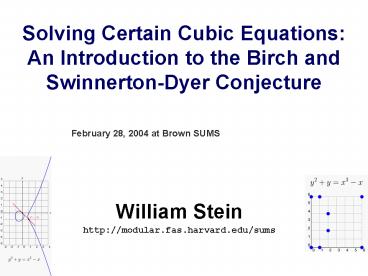Solving Certain Cubic Equations: An Introduction to the Birch and SwinnertonDyer Conjecture - PowerPoint PPT Presentation
1 / 33
Title:
Solving Certain Cubic Equations: An Introduction to the Birch and SwinnertonDyer Conjecture
Description:
Solving Certain Cubic Equations: An Introduction to the Birch and SwinnertonDyer Conjecture – PowerPoint PPT presentation
Number of Views:87
Avg rating:3.0/5.0
Title: Solving Certain Cubic Equations: An Introduction to the Birch and SwinnertonDyer Conjecture
1
Solving Certain Cubic Equations An Introduction
to the Birch and Swinnerton-Dyer Conjecture
February 28, 2004 at Brown SUMS
- William Stein
- http//modular.fas.harvard.edu/sums
2
Two Types of Equations
Differential Algebraic
3
Pythagorean Theorem
Pythagoras lived approx 569-475 B.C.
4
Babylonians
1800-1600 B.C.
5
Pythagorean Triples
Triples of whole numbers a, b, c such that
6
Enumerating Pythagorean Triples
Line of Slope t
Circle of radius 1
7
Enumerating Pythagorean Triples
If then is a Pythagorean triple.
8
Integer and Rational Solutions
9
Cubic Equations Elliptic Curves
A great bookon elliptic curves by Joe Silverman
Cubic algebraic equations in two unknowns x and y.
10
The Secant Process
11
The Tangent Process
12
Mordells Theorem
The rational solutions of a cubic equation are
all obtainable from a finite number of solutions,
using a combination of the secant and tangent
processes.
1888-1972
13
The Simplest Solution Can Be Huge
M. Stoll
14
Central Question
How many solutions are needed to generate all
solutions to a cubic equation?
Birch and Swinnerton-Dyer
EDSAC in Cambridge, England
15
More EDSAC Photos
Electronic Delay Storage Automatic Computer
16
Conjectures Proliferated
Conjectures Concerning Elliptic Curves By B.J.
Birch
The subject of this lecture is rather a special
one. I want to describe some computations
undertaken by myself and Swinnerton-Dyer on
EDSAC, by which we have calculated the
zeta-functions of certain elliptic curves. As a
result of these computations we have found an
analogue for an elliptic curve of the Tamagawa
number of an algebraic group and conjectures
(due to ourselves, due to Tate, and due to
others) have proliferated. though the
associated theory is both abstract and
technically complicated, the objects about which
I intend to talk are usually simply defined and
often machine computable experimentally we have
detected certain relations between different
invariants, but we have been unable to approach
proofs of these relations, which must lie very
deep.
17
Mazurs Theorem
For any two rational a, b, there are at most 15
rational solutions (x,y) to with finite order.
18
Solutions Modulo p
A prime number is a whole number divisible only
by itself and 1. The first few primes are
We say that (x,y), with x,y integers, is a
solution modulo p to if p is a factor of the
integer This idea generalizes to any cubic
equation.
19
Counting Solutions
20
The Error Term
21
More Primes
22
Cryptographic Application
23
Guess
If a cubic curve has infinitely many solutions,
then probably N(p) is larger than p, for many
primes p. Thus maybe the product of
terms will tend to 0 as M gets larger.
Swinnerton-Dyer
24
A Differentiable Function
More precisely, Birch and Swinnerton-Dyer defined
a differentiable function such that formally
Swinnerton-Dyer
25
The Birch and Swinnerton-Dyer Conjecture
The order of vanishing of at 1 is the number
of solutions required to generate all solutions
(we automatically include finite order solutions,
which are trivial to find). CMI 1000000
for a proof!
Bryan Birch
26
Birch and Swinnerton-Dyer
27
Graphs of
The graph of vanishes to order r.
28
Examples of that appear to vanish to
order 4
29
Congruent Number Problem
Open Problem Decide whether an integer n is the
area of a right triangle with rational side
lengths.Fact Yes, precisely when the cubic
equationhas infinitely many solutions
6
30
Connection with BSD Conjecture
Theorem (Tunnell) The Birch and Swinnerton-Dyer
conjecture implies that there is a simple
algorithm that decides whether or not a given
integer n is a congruent number.
See Koblitz for more details.
31
Gross-Zagier Theorem
Benedict Gross
When the order of vanishing of at 1 is
exactly 1, then there isa nontorsion point on E.
Don Zagier
Subsequent work showed that this implies that the
Birch and Swinnerton-Dyer conjecture is true when
has order of vanishing 1 at 1.
32
Kolyvagins Theorem
Theorem. If fE(1) is nonzero then there are only
finitely many solutions to E.
33
Thank You
- Acknowledgements
- Benedict Gross
- Keith Conrad
- Ariel Shwayder (graphs of )































